X-ray Protection Aprons are a type of protective gear used in healthcare settings to protect healthcare professionals and patients from ionizing radiation exposure during diagnostic imaging procedures. Here are seven important things to know about lead aprons and how they work to protect the body:
1. Composition of Lead Aprons
Lead aprons are typically made of lead or lead composite materials, which are embedded in rubber or vinyl coverings. The lead component acts as a powerful barrier that absorbs radiation before it reaches vital organs.
2. How Lead Aprons Work
Lead has a high atomic number, making it exceptionally effective at blocking ionizing radiation such as X-rays and gamma rays. When radiation comes in contact with the apron, the lead absorbs and scatters the rays, drastically reducing the amount that penetrates through to the body.
3. Protects Vital Organs
X-ray Protection Aprons are designed to protect key areas of the body that are most vulnerable to radiation damage, including the chest, abdomen, and reproductive organs. By blocking radiation, they reduce the risk of long-term health problems such as cancer, infertility, and genetic mutations.
4. Usage by Healthcare Workers and Patients
Radiologists, surgeons, dental technicians, and radiographers routinely wear lead aprons when they operate imaging equipment. Patients undergoing X-rays or other radiologic tests may also be given lead aprons to protect their organs from incidental exposure.
5. Radiation Safety Standards
X-ray Protection Aprons are regulated under strict safety standards to ensure adequate protection. They come in different lead equivalences (thicknesses), usually ranging from 0.25 mm to 0.5 mm, depending on the level of protection required for different radiation exposure situations.
6. Lifespan and Maintenance
With regular use, X-ray Protection Aprons may develop cracks or tears, reducing their protective ability. They should be inspected routinely for wear and tear, and users should replace them when damage is found. Proper storage, such as hanging them flat, is also crucial to maintaining their lifespan.
7. Alternatives to Lead
As technology advances, lighter, more comfortable alternatives to lead aprons are emerging, including lead-free or lead-composite aprons. These new materials offer similar radiation protection while reducing the weight burden on users during long surgical or imaging procedures.







